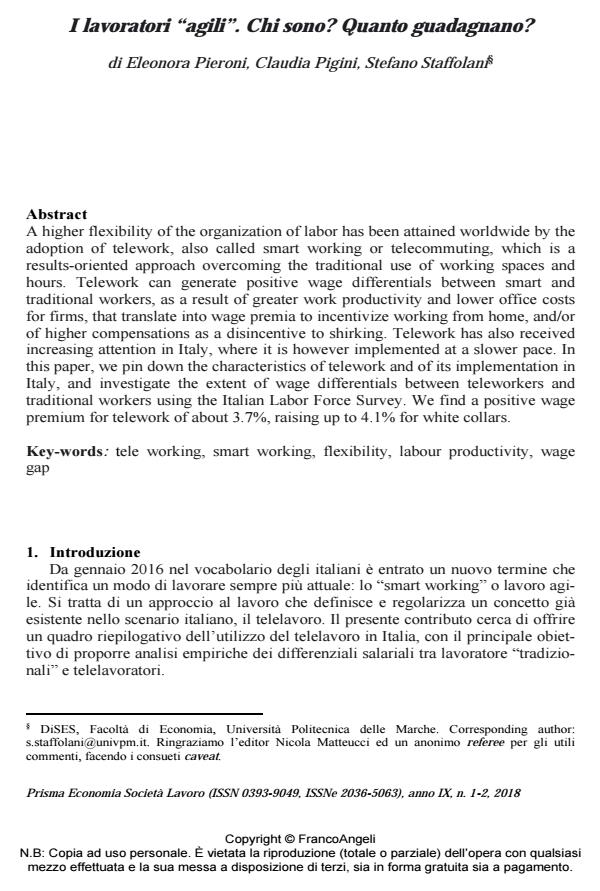I lavoratori "agili". Chi sono? Quanto guadagnano?
Journal title PRISMA Economia - Società - Lavoro
Author/s Eleonora Pieroni, Claudia Pigini, Stefano Staffolani
Publishing Year 2019 Issue 2018/1-2 Language Italian
Pages 10 P. 67-76 File size 208 KB
DOI 10.3280/PRI2018-001005
DOI is like a bar code for intellectual property: to have more infomation
click here
Below, you can see the article first page
If you want to buy this article in PDF format, you can do it, following the instructions to buy download credits

FrancoAngeli is member of Publishers International Linking Association, Inc (PILA), a not-for-profit association which run the CrossRef service enabling links to and from online scholarly content.
A higher flexibility of the organization of labor has been attained worldwide by the adoption of telework, also called smart working or telecommuting, which is a results-oriented approach overcoming the traditional use of working spaces and hours. Telework can generate positive wage differentials between smart and traditional workers, as a result of greater work productivity and lower office costs for firms, that translate into wage premia to incentivize working from home, and/or of higher compensations as a disincentive to shirking. Telework has also received increasing attention in Italy, where it is however implemented at a slower pace. In this paper, we pin down the characteristics of telework and of its implementation in Italy, and investigate the extent of wage differentials between teleworkers and traditional workers using the Italian Labor Force Survey. We find a positive wage premium for telework of about 3.7%, raising up to 4.1% for white collars.
Keywords: Tele working, smart working, flexibility, labour productivity, wage gap
- Baumeister R.F. and Leary M.R., (1995) “The need to belong: Desire on interpersonal attachments as a fundamental human motivation”, Psychological Bulletin, Vol. 117, No. 3, pp. 497-529
- Becker G.S., and Murphy K.M., (1992) “The division of labor, coordination costs and Knowledge”, Quarterly journal of economics, 107, pp.1137-1160
- Connelly J., (1995) “Let’s hear it for the office”, Fortune, 131, pp. 221-222
- Corso M., Gandini I. and Crespi F., (2013) “La diffusione e i benefici dello smart working in Italia”, report, Dipartimento di ingegneria gestionale, Politecnico di Milano, Milan
- Dahlstrom T.R., (2013) “Telecommuting and leadership style”, Public Personnel Management, 42, pp. 438-452
- Eurofound, (2010) “Telework in the European Union”, Eurofund Report, Loughlinstown, -- disponibile a: https://www.eurofound.europa.eu/publications/report/2010/telework-in-the-european-union
- Gajendran R.S. and Harrison D.A., (2007) “The good, the bad and the unknown about telecommuting: meta-analysis of psychological mediators and individual consequences”, Journal of applied psychology, Vol. 92, No. 6, pp. 1524-1541
- Glass J.L., and Noonan M.C., (2016) “Telecommuting and earnings trajectories among American women and men 1989-2008”, Social Forces, pp.1-34
- Golden T.D., Veiga J. and Simsek Z., (2006), “Telecommuting’s differential impact on work-family conflict: Is there no place like home?”, Journal of Applied Psychology, 91, pp. 1340-1350
- Greenhaus J. and Beutell N., (1985) “Sources and conflict between work and family roles”, Academy of Management Review, Vol. 10, pp. 76-88
- Harpaz I., (2002) “Advantages and disadvantages of telecommuting for the individual, organization and society”, Work study, Vol. 51, No. 2, pp. 74-80
- Hesse B. and Grantham C.E., (1991) “Electronically distributed work communities: implications for research on telework”, Electronic networking: Research application and policy, Vol. 1, pp. 4-17
- Igbaria M. and Guimaraes T., (1999) “Exploring differences in employee turnover intentions and its determinants among telecommuters and non-telecommuters”, Journal of management information systems”, Vol. 16, No. 1, pp. 147-1164
- Johnson N.B. and Provan K.G., (1995) “The relationship between work/family benefits and earnings: a test of competing predictions”, Journal of socio-economics, Vol. 24, No. 4, pp. 571-584
- Mason J.C., (1993) “Workplace 200: The death of 9 to 5?”, Management Review, 82, pp.14-18
- Pérez M.P., Sànchez A.M. and de Louis Carnicer M.P., (2002) “Benefits and barriers of telework: differences of human resources managers according to company’s operations strategy”, Technovation, 22, pp. 775-783
- Pigini C. and Staffolani S., (2019) “Teleworkers in Italy: who are they? Do they make more?”, International Journal of Manpower, DOI: 10.1108/IJM-07-2017-015
- Schroeder C. and Warren R.S., (2005) “The effect of home-based work on earnings”, Unpublished manuscript
- Thomas L.T. and Ganster D.C., (1995) “Impact of family-supportive work variables on work-family conflict and strain: a control perspective”, Journal of applied psychology, 80, pp. 6-15
- Winder K.L., (2009) “Flexible work arrangements and wages: do firm characteristics matter?”, Working paper, University of California-Merced
Eleonora Pieroni, Claudia Pigini, Stefano Staffolani, I lavoratori "agili". Chi sono? Quanto guadagnano? in "PRISMA Economia - Società - Lavoro" 1-2/2018, pp 67-76, DOI: 10.3280/PRI2018-001005